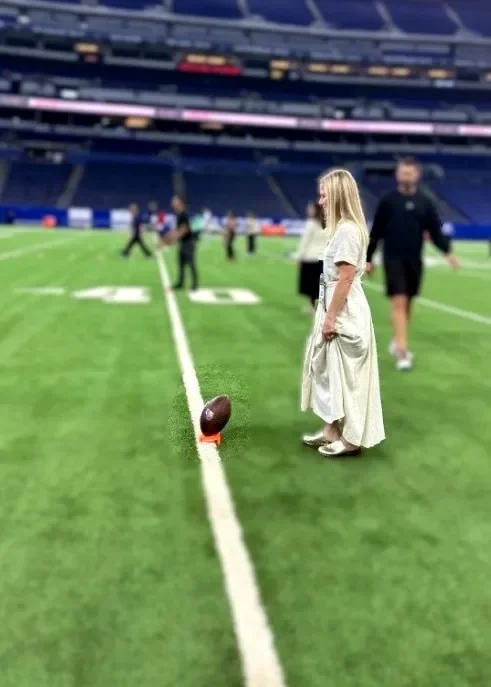ExciTED to Experience the Inaugural TedSports Conference
What I Learned About the Future of Sports (Spoiler: It's Complicated)
Picture this: I'm standing on Lucas Oil Stadium field in a dress and clogs, attempting to kick a field goal while learning life lessons from a former NFL kicker. That's just Wednesday at the inaugural TedSports conference in Indianapolis.
But before we get to my questionable footwear choices, let's talk about Indianapolis itself. Go Indy! The city has quietly transformed into the sports mecca of the Midwest. With the Fever's meteoric rise, the Pacers and Colts holding court, plus hosting everything from the Indy 500 to USA Swimming Championships, and serving as the home of the NCAA, the energy is palpable. It was the perfect backdrop for a conference about the future of sports. Kudos to the organizers, especially co-chair Neelay Bhatt, whose enthusiasm was genuinely infectious, and high fives to all the cool people I met over the course of the week and hope to stay connected with.
TedSports planted some seeds with some “ideas worth spreading.” Here are some of the themes that popped up throughout the presentations that really resonated with me.
We Need to Roll Up Our Sleeves When It Comes to Women in Sports
Here's what's working: girls who play sports become women who lead. Kate Johnson, Google’s Global Marketing Director, laid it out for us. In fact, 94% of women in the C-Suite played sports.
Here's what's not working: we continue to have issues with access, participation, and parity.
Tamika Catchings—WNBA legend and one of the most decorated players in league history—put it perfectly: "Greatness in sports is only part of the equation. We need greatness in the system, too." Translation: individual talent isn't enough when the infrastructure needs work. Creating spaces where girls can play and learn is a critical first step, so she’s doing it by helping to develop a sports and leadership campus for girls.
Troy Vincent, former NFL player turned executive, delivered the quote I wish every media outlet and sports executive could display on their office wall: "We commercialize sport for men, yet are satisfied with access for women." Access. Not investment. Just access. Let’s fix that.
Equitable pay for women and investment in women’s sports need to be part of today’s conversations, too. Briana Scurry, gold medal goalkeeper and pioneer of the first paid professional women’s soccer league, and Hope Solo, World Cup champion goalkeeper and sports equity activist, noted that a heck of a lot of women had to fight for many years to be heard on the issue of pay equity in soccer. It wasn’t until women had a seat at the leadership table that pay equity was considered. And there are still too few female leaders in sports front offices as one of the panels noted. More women in leadership positions may make it easier to have productive parity conversations.
Here’s the idea worth spreading: let’s keep nurturing careers for women in sports and on the playing field. Let’s watch, invest, mentor, and show up to support youth sports. Get girls to play and stay in sports as table stakes so they can be our future leaders.
Youth Sports Has a $40 Billion Elephant in the Room
Remember when kids played sports for fun? That’s nostalgia now.
Youth sports have become a $40 billion industry with an "up or out" mentality, as Tom Farrey from the Aspen Institute's Project Play explained. Can't pay for elite training? There are limited opportunities to play for free. This even though "having fun" remains the top reason kids want to play sports.
Charlie Baker, current NCAA president, proposed a solution: make sports accessible to everyone from kindergarten through high school with "no cut" policies, funded by sports betting proceeds. Why not? This seems like a reasonable and rational approach to ensure kids are not priced out of “fun.” Let’s make it happen!
Meanwhile, Rich Felton-Thomas of ai.io demonstrated technology that could democratize talent discovery—think AI scouts finding the next great athlete in places traditional scouts don’t have time to visit or would never venture. If we're going to live with the commercialization of youth sports, at least let's make sure we're not missing talent because of geography or economics.
What Kicking Field Goals Taught Me About Fear (And Life)
Back to me in clogs on an NFL field.
Former NFL kicker Stephen Hauschka led, for me, the most unexpectedly useful workshop of the conference. Here's a guy who lived in the ultimate pressure cooker—where missing a kick can lose a game, end a season, or define a career.
His insight? "There's more to life than the game. It's who we become in the process." Boom. Doesn’t this apply to everything?
Troy Vincent captured the transferable magic of sports perfectly: "Read a defense, read a room. Call an audible, solve a problem." These aren't just sports skills—they're life skills.
But Stephen's workshop went deeper. Standing on that field, learning to approach fear both mentally and physically, I understood his most powerful lesson: the opposite of fear isn't courage—it's love. Love for your abilities, the opportunity, the moment itself.
Imagine if we could infuse this mindset in youth sports instead of just focusing on winning or developing elite athletes. Imagine if we helped kids fall in love with trying, regardless of the outcome, and love themselves for taking the kick. As Gilberto Silva, Brazilian former pro footballer, said in his presentation, “Change comes when you imagine the world that could be and build it.” Let’s get to building it!
PS I'll never be a field goal kicker, but I absolutely loved myself for trying. And yes, the clogs were a terrible choice, but the lesson was priceless.

